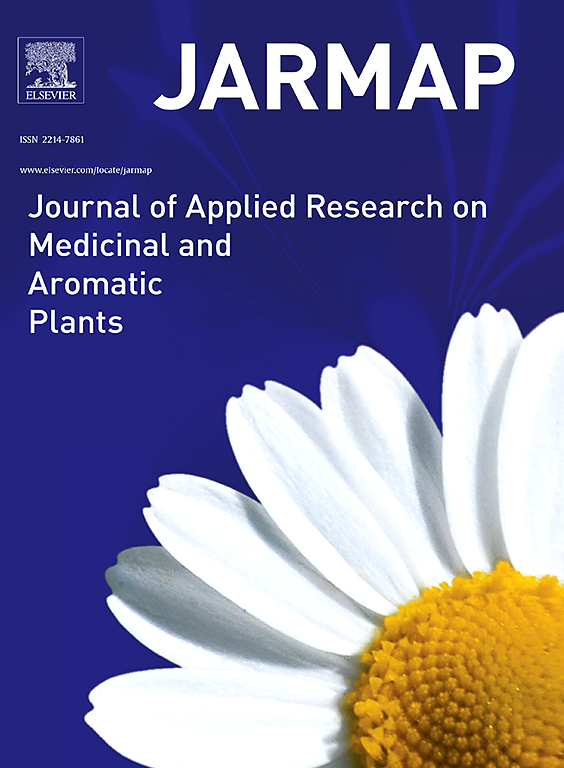Enhancing phenolic compounds recovery from Arnica montana L. flowers through optimized green extraction protocols
IF 3.6
2区 农林科学
Q1 PLANT SCIENCES
Journal of Applied Research on Medicinal and Aromatic Plants
Pub Date : 2024-10-30
DOI:10.1016/j.jarmap.2024.100600
引用次数: 0
Abstract
The present study aimed to optimize the extraction conditions (time, temperature, and ethanol concentration) of pressurized-liquid and microwave-assisted extraction (PLE and MAE, respectively) to maximize the recovery of phenolic compounds from Arnica montana flowers. To this aim, response surface methodology (RSM) with an experimental design was applied. The studied variable responses were extraction yield and total phenolic content (TPC), expressed as mg/g of sample dry weight (dw) and mg/g of extract. For PLE, the models showed a good adjusted R2 coefficient (0.75–0.92) and no significant lack of fit. MAE models also showed good adjustment, except for TPC expressed per g of dw, where the model showed a significant lack of fit and was not suitable for optimization. The optimal PLE conditions that maximized all response variables were 11 min, 125 °C and 76 % ethanol in water. For MAE, the optimal conditions were 25 min, 115 °C, and 76 % ethanol. Comparing the predicted values, PLE significantly surpassed MAE in terms of TPC, obtaining 389 compared to 246 mg of total phenolics/g of extract for MAE. Validation experiments confirmed the suitability of the predictive models. In the case of PLE, employing extraction cycles under optimal conditions improved phenolic compound extraction, with three extraction cycles leading to a 104 % increase in TPC. Overall, the optimized PLE protocol was considered an efficient methodology for obtaining rich-phenolic extracts, contributing to the expansion of current industrial applications of A. montana.
通过优化绿色萃取方案提高山金车花中酚类化合物的回收率
本研究旨在优化压液萃取和微波辅助萃取(分别为 PLE 和 MAE)的萃取条件(时间、温度和乙醇浓度),以最大限度地回收山金车花中的酚类化合物。为此,采用了响应面方法(RSM)进行实验设计。研究的响应变量为提取率和总酚含量(TPC),分别以毫克/克样品干重(dw)和毫克/克提取物表示。对于 PLE,模型显示出良好的调整 R2 系数(0.75-0.92),没有明显的拟合不足。MAE 模型也显示出良好的调整性,但以每克干重表示的 TPC 模型显示出明显的拟合度不足,不适合进行优化。使所有响应变量最大化的最佳 PLE 条件为 11 分钟、125 °C 和 76% 的乙醇水溶液。对于 MAE,最佳条件是 25 分钟、115 °C、76% 的乙醇。与预测值相比,PLE 的总酚含量明显超过 MAE,达到 389 毫克/克提取物,而 MAE 为 246 毫克/克提取物。验证实验证实了预测模型的适用性。就 PLE 而言,在最佳条件下采用萃取循环提高了酚类化合物的萃取率,三个萃取循环使 TPC 提高了 104%。总之,优化的 PLE 方案被认为是获得丰富酚类提取物的有效方法,有助于扩大 A. montana 目前的工业应用。
本文章由计算机程序翻译,如有差异,请以英文原文为准。
求助全文
约1分钟内获得全文
求助全文
来源期刊

Journal of Applied Research on Medicinal and Aromatic Plants
Pharmacology, Toxicology and Pharmaceutics-Drug Discovery
CiteScore
6.40
自引率
7.70%
发文量
80
审稿时长
41 days
期刊介绍:
JARMAP is a peer reviewed and multidisciplinary communication platform, covering all aspects of the raw material supply chain of medicinal and aromatic plants. JARMAP aims to improve production of tailor made commodities by addressing the various requirements of manufacturers of herbal medicines, herbal teas, seasoning herbs, food and feed supplements and cosmetics. JARMAP covers research on genetic resources, breeding, wild-collection, domestication, propagation, cultivation, phytopathology and plant protection, mechanization, conservation, processing, quality assurance, analytics and economics. JARMAP publishes reviews, original research articles and short communications related to research.
 求助内容:
求助内容: 应助结果提醒方式:
应助结果提醒方式:


